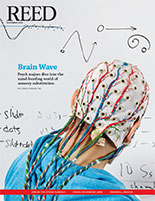
IRIS login | Reed College home Volume 93, No. 4: December 2014
Prime Exponent
As a budding physics major, I took Math 11 in 1955 as one of my first required courses. It was common knowledge that the Reed math courses were not going to help us solve physics problems, so practical math also was taught. I never did well at math department offerings. I believe my supreme agony occurred under Prof. Joe Roberts’ patient nurturing the following year). Nevertheless, I did learn some useful rules along the way. Let me stylize 2 squared as 2^2 and 2 cubed as 2^3 = 2 x 2 x 2. The article “Prime Exponent” noted that Prof. Roberts retired after teaching 2^(2^3) - 2 years. However, 2^3 is 2 x 2 x 2 = 8, and 2^8 now becomes 2 x 2 x 2 x 2 x 2 x 2 x 2 x 2 = 256, so 2^8 - 2 = 254 years. I’d like to think that the purity of mathematics could lead to such longevity, but suspect that what you meant was (2^2)^3, or (2 squared) to the 3rd power = (4 x 4 x 4), or 64 – 2 = 62. With exponents you work backwards, or downwards, from the last one. Simple as this all seems, it is perhaps one of the few times I did anything correct with reference to math and Reed.
![]()
Our postman brought the September 2014 Reed magazine to our house on his motorcycle this morning. Skimming through, I noticed something rather odd in the article about Prof. Joe Roberts: he taught at Reed for 254 years! Yes, that is the figure indicated in the subtitle, because 2 cubed = 8 and thus 2 to the 8th minus 2 = 256 - 2 = 254. Then again, perhaps we should be embarrassed, rather than amazed, that the writer, headline editor, and you all seemed to think 2 to the 2 to the 3 = 2 to the 6th or 64. This is what happens when our society at large disses basic calculation as mere “bean counting.”

LATEST COMMENTS
steve-jobs-1976 I knew Steve Jobs when he was on the second floor of Quincy. (Fall...
Utnapishtim - 2 weeks ago
Prof. Mason Drukman [political science 1964–70] This is gold, pure gold. God bless, Prof. Drukman.
puredog - 1 month ago
virginia-davis-1965 Such a good friend & compatriot in the day of Satyricon...
czarchasm - 4 months ago
John Peara Baba 1990 John died of a broken heart from losing his mom and then his...
kodachrome - 7 months ago
Carol Sawyer 1962 Who wrote this obit? I'm writing something about Carol Sawyer...
MsLaurie Pepper - 8 months ago
William W. Wissman MAT 1969 ...and THREE sisters. Sabra, the oldest, Mary, the middle, and...
riclf - 10 months ago